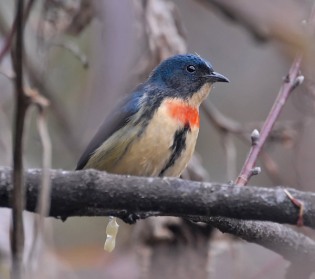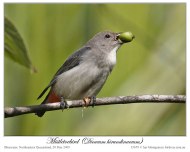The flowers appear on the earth; The time of singing has come (Song of Solomon 2:12a NKJV)
CLASS – AVES, Order – PASSERIFORMES, Family – Dicaeidae – Flowerpeckers
*
Latest I.O.C. Version
Species (48)
*
Olive-backed Flowerpecker (Prionochilus olivaceus)
Yellow-breasted Flowerpecker (Prionochilus maculatus)
Crimson-breasted Flowerpecker (Prionochilus percussus)
Palawan Flowerpecker (Prionochilus plateni)
Yellow-rumped Flowerpecker (Prionochilus xanthopygius)
Scarlet-breasted Flowerpecker (Prionochilus thoracicus)
Golden-rumped Flowerpecker (Dicaeum annae)
Thick-billed Flowerpecker (Dicaeum agile)
Striped Flowerpecker (Dicaeum aeruginosum)
Brown-backed Flowerpecker (Dicaeum everetti)
Whiskered Flowerpecker (Dicaeum proprium)
Yellow-vented Flowerpecker (Dicaeum chrysorrheum)
Yellow-bellied Flowerpecker (Dicaeum melanoxanthum)
Legge’s Flowerpecker (Dicaeum vincens)
Yellow-sided Flowerpecker (Dicaeum aureolimbatum)
Olive-capped Flowerpecker (Dicaeum nigrilore)
Flame-crowned Flowerpecker (Dicaeum anthonyi)
Bicolored Flowerpecker (Dicaeum bicolor)
Red-keeled Flowerpecker (Dicaeum australe)
Black-belted Flowerpecker (Dicaeum haematostictum)
Scarlet-collared Flowerpecker (Dicaeum retrocinctum)
Cebu Flowerpecker (Dicaeum quadricolor)
Orange-bellied Flowerpecker (Dicaeum trigonostigma)
Buzzing Flowerpecker (Dicaeum hypoleucum)
Pale-billed Flowerpecker (Dicaeum erythrorhynchos)
Nilgiri Flowerpecker (Dicaeum concolor)
Plain Flowerpecker (Dicaeum minullum)
Andaman Flowerpecker (Dicaeum virescens)
Pygmy Flowerpecker (Dicaeum pygmaeum)
Crimson-crowned Flowerpecker (Dicaeum nehrkorni)
Flame-breasted Flowerpecker (Dicaeum erythrothorax)
Halmahera Flowerpecker (Dicaeum schistaceiceps)
Ashy Flowerpecker (Dicaeum vulneratum)
Olive-crowned Flowerpecker (Dicaeum pectorale)
Red-capped Flowerpecker (Dicaeum geelvinkianum)
Louisiade Flowerpecker (Dicaeum nitidum)
Red-banded Flowerpecker (Dicaeum eximium)
Midget Flowerpecker (Dicaeum aeneum)
Mottled Flowerpecker (Dicaeum tristrami)
Black-fronted Flowerpecker (Dicaeum igniferum)
Blue-cheeked Flowerpecker (Dicaeum maugei)
Mistletoebird (Dicaeum hirundinaceum)
Grey-sided Flowerpecker (Dicaeum celebicum)
Black-sided Flowerpecker (Dicaeum monticolum)
Fire-breasted Flowerpecker (Dicaeum ignipectus)
Blood-breasted Flowerpecker (Dicaeum sanguinolentum)
Scarlet-backed Flowerpecker (Dicaeum cruentatum)
Scarlet-headed Flowerpecker (Dicaeum trochileum)
On the photos or slides, a “by” indicates one of the photographers or videographers, who have given their permission, with links on our sidebar. Please visit their site to see many more fantastic shots, a “©©” copyright symbol indicates a photo from Creative Commons and ©WikiC is a Creative Commons photo from Wikipedia.
Photographers or Videographers used on this page from our sidebar, Photography, are:
Nikhil Devasar’s Gallery
Back to Family Page – CLICK HERE
*
Articles Mentioning Birds From This Family:
Other Websites that have photos of this Family:
- Flowerpecker – Wikipedia
- Flowerpeckers (Dicaeidae) – IBC
*
The flowerpeckers are a family, Dicaeidae , of passerine birds. The family comprises two genera, Prionochilus and Dicaeum, with 44 species in total. The family has sometimes been included in an enlarged sunbird family Nectariniidae. The berrypeckers of the family Melanocharitidae and the painted berrypeckers, Paramythiidae, were once lumped into this family as well. The family is distributed through tropical southern Asia and Australasia from India east to the Philippines and south to Australia. The family is catholic in its habitat preferences, occupying a wide range of environments from sea level to montane habitats. Some species, such as the Mistletoebird of Australia, are recorded as being highly nomadic over parts of their range.
Nectar forms part of the diet, although they also take berries, spiders and insects. Mistletoes of 21 species in 12 genera have been found to be part of the diet of flowerpeckers, and it is thought that all species have adaptations to eat these berries and dispose of them quickly. (Wikipedia)
Some of the Family – Photos are Alphabetical down the columns:




















